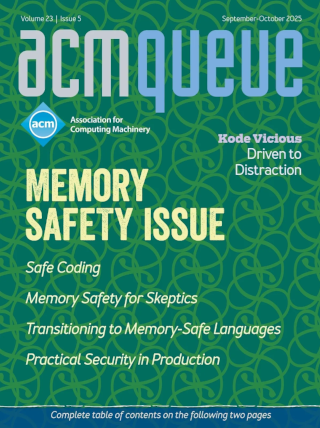
Benchmarking "Hello, World!":
Six different views of the execution of "Hello, World!" show what is often missing in today’s tools
As more and more software moves off the desktop and into data centers, and more and more cell phones use server requests as the other half of apps, observation tools for large-scale distributed transaction systems are not keeping up. This makes it tempting to look under the lamppost using simpler tools. You will waste a lot of high-pressure time following that path when you have a sudden complex performance crisis. Instead, know what each tool you use is blind to, know what information you need to understand a performance problem, and then look for tools that can actually observe that information directly.
CodeFlow: Improving the Code Review Process at Microsoft:
A discussion with Jacek Czerwonka, Michaela Greiler, Christian Bird, Lucas Panjer, and Terry Coatta
Delivering a new set of capabilities for managing and improving Microsoft’s code-review process was the primary goal right from the start. In the course of accomplishing that, much was also learned about certain general code-review principles. In fact, subsequent research has offered surprising evidence of just how similar the impact can be when many of these principles are followed at companies other than Microsoft.
Security for the Modern Age:
Securely running processes that require the entire syscall interface
Giving operators a usable means of securing the methods they use to deploy and run applications is a win for everyone. Keeping the usability-focused abstractions provided by containers, while finding new ways to automate security and defend against attacks, is a great path forward.
The Importance of a Great Finish:
You have to finish strong, every time.
How can you make sure that you are recognized as a valuable member of your team, whose work is seen as critical to the team’s success? You have to finish strong, every time. Here is how to keep your momentum up and make the right moves to be a visible contributor to the final success of every project.
Writing a Test Plan:
Establish your hypotheses, methodologies, and expected results.
If you can think of each of your tests as an experiment with a hypothesis, a test methodology, and a test result, it should all fall into place rather than falling through the cracks.
Tear Down the Method Prisons! Set Free the Practices!:
Essence: a new way of thinking that promises to liberate the practices and enable true learning organizations
This article explains why we need to break out of this repetitive dysfunctional behavior, and it introduces Essence, a new way of thinking that promises to free the practices from their method prisons and thus enable true learning organizations.
SQL is No Excuse to Avoid DevOps:
Automation and a little discipline allow better testing, shorter release cycles, and reduced business risk.
Using SQL databases is not an impediment to doing DevOps. Automating schema management and a little developer discipline enables more vigorous and repeatable testing, shorter release cycles, and reduced business risk. When you can confidently deploy new releases, you do it more frequently. New features that previously sat unreleased for weeks or months now reach users sooner. Bugs are fixed faster. Security holes are closed sooner. It enables the company to provide better value to customers.
Understanding Database Reconstruction Attacks on Public Data:
These attacks on statistical databases are no longer a theoretical danger.
With the dramatic improvement in both computer speeds and the efficiency of SAT and other NP-hard solvers in the last decade, DRAs on statistical databases are no longer just a theoretical danger. The vast quantity of data products published by statistical agencies each year may give a determined attacker more than enough information to reconstruct some or all of a target database and breach the privacy of millions of people. Traditional disclosure-avoidance techniques are not designed to protect against this kind of attack.



